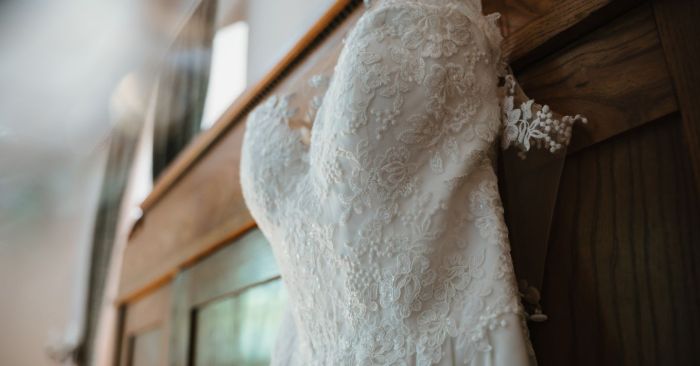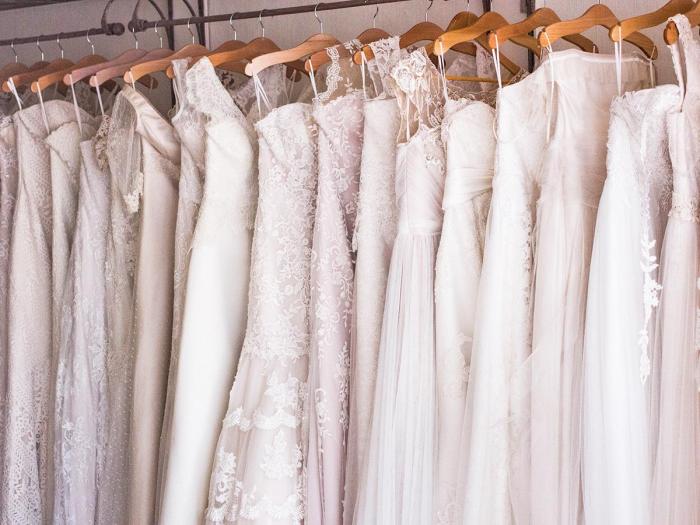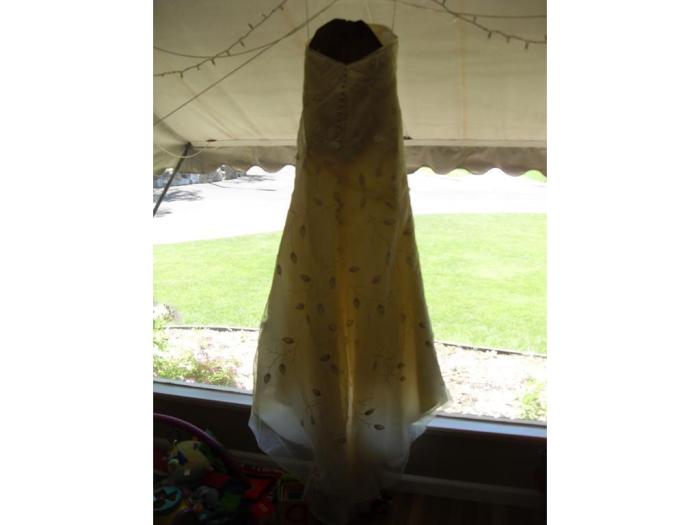Wedding Dress Used Sell Your Gown
Market Analysis of Used Wedding Dresses
Wedding dress used sell – The market for pre-owned wedding dresses is experiencing significant growth, driven by increasing affordability concerns and a growing awareness of sustainable fashion choices. This section analyzes the current market size, trends, key demographics, and pricing strategies within this thriving sector.
Market Size and Trends
While precise market size figures are difficult to obtain, anecdotal evidence and sales data from online platforms suggest a substantial and rapidly expanding market for used wedding dresses. Trends indicate a preference for designer gowns and unique styles, often at a fraction of the original retail price. The rise of online marketplaces and social media has significantly contributed to this market’s expansion, providing greater accessibility and reach for both buyers and sellers.
Buyer and Seller Demographics
Buyers typically comprise budget-conscious brides, environmentally aware consumers, and those seeking unique or vintage styles. Sellers often include brides who wish to recoup some of their initial investment or simply want to give their dress a second life. The demographic is broad, encompassing various age groups and socioeconomic backgrounds.
Pricing Strategies Across Platforms
Online marketplaces like Stillwhite and Once Wed often feature a range of pricing strategies, from fixed prices to auction-style listings. Consignment shops typically take a percentage of the final sale price. Offline options, such as bridal consignment boutiques, generally operate on a commission basis. Pricing strategies vary significantly depending on the platform, the dress’s condition, brand, and style.
Average Price Range of Used Wedding Dresses
| Brand | Condition | Style | Average Price Range (USD) |
|---|---|---|---|
| Designer (e.g., Vera Wang, Pronovias) | Excellent | A-line | $1000 – $3000 |
| Designer (e.g., Vera Wang, Pronovias) | Good | Ballgown | $700 – $2000 |
| Non-Designer | Excellent | Sheath | $300 – $800 |
| Non-Designer | Good | Mermaid | $200 – $500 |
Selling Platforms and Strategies
Choosing the right platform and implementing a robust marketing strategy are crucial for successfully selling a used wedding dress. This section compares various selling platforms and Artikels effective marketing techniques.
Comparison of Selling Platforms

Source: cheapism.com
Online marketplaces offer wide reach but may involve higher fees. Consignment shops provide convenience but typically result in lower profit margins. Social media platforms like Instagram and Facebook can be effective for targeted marketing but require more hands-on management. Each platform has its own advantages and disadvantages, impacting reach, fees, and the overall selling process.
- Online Marketplaces: Wide reach, established buyer base, but higher fees and competition.
- Consignment Shops: Convenience, less management, but lower profit margins and potential for slower sales.
- Social Media: Targeted marketing, potential for direct engagement, but requires active management and may not reach as broad an audience.
Online Marketing Strategy
A compelling listing includes high-quality photos, a detailed and accurate description, and competitive pricing. Using relevant s and hashtags is essential for improved search engine optimization ().
Effective Product Descriptions and Photographs
Professional-looking photographs are paramount. Images should showcase the dress from multiple angles, highlighting its details and condition. The description should accurately reflect the dress’s features, size, condition, and any alterations made. Examples of effective descriptions might include specific details about the fabric, embellishments, and any minor imperfections.
Social Media Campaign
A social media campaign should leverage relevant hashtags, engaging visuals, and targeted advertising. Examples of effective hashtags include #preownedweddingdress, #usedweddingdress, #sustainablewedding, and #weddingdressforsale. Posts should highlight the dress’s unique features and the benefits of buying pre-owned.
Pricing and Negotiation
Determining a fair market value and negotiating effectively are key to a successful sale. This section explores factors influencing price, negotiation tactics, and strategies for setting a price.
Factors Influencing Price
Several factors influence a used wedding dress’s price, including designer brand, condition (excellent, good, fair), age, style, and size. A designer gown in excellent condition will command a higher price than a non-designer dress in fair condition. The dress’s style and current trends also impact its value.
Negotiation Tactics

Source: weddingdressesguide.com
Buyers should research comparable listings to determine a fair offer. Sellers should be prepared to negotiate but should also know their bottom line. Both parties should communicate respectfully and professionally.
Determining Fair Market Value
Researching similar dresses sold on various platforms provides a benchmark. Consider the dress’s original price, condition, and any alterations. A fair market value balances the dress’s condition and desirability with the buyer’s budget.
Step-by-Step Pricing and Offer Response
- Research comparable listings.
- Consider the dress’s condition and features.
- Set an initial price.
- Respond to offers promptly and professionally.
- Be prepared to negotiate within a reasonable range.
Legal and Ethical Considerations
Selling used goods online involves legal and ethical responsibilities. This section addresses consumer protection laws, transparency, returns, and secure transactions.
Legal Requirements for Selling Used Goods
Understanding consumer protection laws is crucial. Accurate descriptions and transparent disclosure of the dress’s condition are essential to avoid legal disputes. Compliance with relevant regulations regarding online sales and consumer rights is vital.
Ethical Considerations and Transparency
Honesty and transparency are paramount. Accurately describing the dress’s condition, including any flaws or imperfections, builds trust and avoids potential misunderstandings or disputes. Open communication fosters positive buyer-seller relationships.
Handling Returns and Exchanges, Wedding dress used sell
Establishing a clear return policy upfront is advisable. This policy should Artikel the conditions for returns, the timeframe for returns, and the process for refunds or exchanges. A well-defined policy protects both the buyer and the seller.
Checklist for Safe and Secure Transactions
- Use secure payment methods (e.g., PayPal, escrow services).
- Obtain proof of delivery.
- Communicate clearly and professionally throughout the transaction.
- Keep records of all communications and transactions.
Presentation and Photography: Wedding Dress Used Sell
High-quality photography is essential for showcasing a used wedding dress effectively. This section provides guidance on taking professional-looking photographs and presenting the dress to its best advantage.
Importance of High-Quality Photography
Professional-looking photos significantly increase the chances of a sale. High-quality images highlight the dress’s details, condition, and overall appeal, attracting potential buyers and conveying a sense of professionalism.
Taking Professional-Looking Photographs
Use good lighting (natural light is ideal), a clean and uncluttered background, and a mannequin or dress form for optimal presentation. Experiment with different angles and poses to showcase the dress’s design and silhouette. Consider using editing software to enhance the images without altering the dress’s true appearance.
Presenting the Dress to Highlight Features
Steaming or pressing the dress before photographing is essential. Use appropriate hangers or dress forms to maintain its shape. Focus on highlighting the dress’s most attractive features while minimizing any imperfections. Consider using accessories to enhance the overall presentation.
Using Different Angles and Poses
Capture the dress from various angles—front, back, sides, and close-ups of details. Consider showcasing the dress on a model or mannequin to illustrate its fit and drape. Different poses and angles can highlight specific design elements and overall silhouette.
Post-Sale Process

Source: googleusercontent.com
The post-sale process is equally important as the pre-sale stages. This section Artikels the steps involved in packaging, shipping, handling payments, and obtaining feedback.
Packaging and Shipping
Use appropriate packaging materials to protect the dress during shipping. A sturdy box, acid-free tissue paper, and bubble wrap are essential. Consider using a reputable shipping service with insurance to protect against loss or damage. Clearly label the package with appropriate handling instructions.
Handling Payments and Payment Disputes
Use secure payment methods and keep records of all transactions. Address payment disputes promptly and professionally, following the platform’s dispute resolution procedures if necessary. Clear communication and documentation are key to resolving payment issues.
Providing Excellent Customer Service
Respond to buyer inquiries promptly and courteously. Provide tracking information and follow up after delivery. Excellent customer service fosters positive reviews and builds a strong reputation.
Obtaining and Utilizing Feedback
Request feedback from buyers to assess the overall experience and identify areas for improvement. Positive reviews can attract future buyers. Use constructive criticism to refine your selling process and enhance future listings.
Questions Often Asked
How long does it typically take to sell a used wedding dress?
The timeframe varies greatly depending on factors like dress condition, designer, price, and marketing efforts. It could range from a few weeks to several months.
Selling a used wedding dress often involves navigating sizing discrepancies. To ensure a smooth transaction and accurate representation for potential buyers, utilizing a reliable wedding dress size calculator can be incredibly helpful. This tool assists in converting measurements to standard sizing, clarifying the dress’s fit and avoiding misunderstandings with interested parties, ultimately leading to a more successful sale of your pre-owned gown.
What are some common scams to watch out for when selling a wedding dress online?
Be wary of buyers who request payment via untraceable methods or pressure you into quick transactions. Always use secure payment platforms and verify buyer identities when possible.
How should I handle potential damage claims after the dress has shipped?
Require a signature upon delivery and always use insured shipping. Clearly document the dress’s condition before shipping with photos and videos. If damage occurs, file a claim with the shipping carrier.
What if a buyer wants to return the dress?
Establish a clear return policy upfront in your listing. Consider offering a limited return window with a restocking fee and conditions for acceptance of returns (e.g., dress must be in original condition).

















